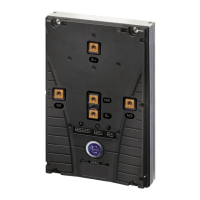AC TRACTION – INSTALLATION PG DRIVES TECHNOLOGY
The active range of the input when used by a steering potentiometer is defined by the parameters, 1.25 Steer Pot. Min.,
1.26 Steer Pot. Mid. and 1.27 Steer Pot. Max. 1.25 Steer Pot. Min. sets the voltage that relates to the minimum (full left hand
lock) steering angle, while 1.27 Steer Pot. Max. sets the voltage that relates to the maximum (full right hand lock) steering
angle. 1.26 Steer Pot. Mid. corresponds to a 0° steering angle, i.e. the vehicle performs no steering operation.
Pin 5 – +12V Supply
A 12V supply with a maximum current of 20mA. This output can be used for the motor encoder supply.
Pin 6 – 0V
A 0V connection point for the Speed Encoder and Steering Potentiometer.
Avoid routing the 6-way motor feedback cables close to the motor power cables - they must not
be tie-wrapped together. If screened cable is used, contact PGDT for details on how to connect
this at the motor and controller ends. This is critical to help avoid any noise or incorrect speed
measurement issues.
7 Electromagnetic Compatibility (E.M.C.)
You should consider EMC and perform relevant tests as early as possible in the design phase.
7.1 Emissions
Any high-speed switch is capable of generating harmonics at frequencies that are many multiples of its basic operating
frequency. It is the objective of a good installation to contain or absorb the resultant emissions. All wiring is capable of acting as
a receiving or transmitting antenna. Wiring should be arranged to take maximum advantage of the structural metal work inherent
in most vehicles. Vehicle metalwork should be electrically linked with conductive braids.
7.1.1 Power Cables
All cables should be routed within the vehicle framework and kept as low in the structure as is practical; a cable run within a main
chassis member is better screened from the environment than one routed through or adjacent to an overhead guard. Power
cables should be kept short to minimize emitting and receiving surfaces. Shielding by the structure may not always be sufficient;
cables run through metal shrouds may be required to contain emissions.
Parallel runs of cables in common circuits can serve to cancel emissions, e.g. the battery positive and negative cables following
similar paths.
Tie all cables into a fixed layout and do not deviate from the approved layout in production vehicles. A re-routed battery cable
could negate any approvals obtained.
7.1.2 Signal Cables
All wiring harnesses should be kept short. Wiring should be routed close to the vehicle metalwork. All signal wires should be kept
clear of power cables or made from screened cable. This is particularly important if the control wiring carries analogue
information, e.g. Accelerator wiring. Tie all wiring securely and ensure it always follows the same layout.
7.1.3 Controller
Thermal and EMC (emissive) requirements tend to work in opposition. Additional insulation between the controller assembly and
the vehicle framework reduces capacitive coupling and hence emissions but tends to reduce the thermal performance. A
working balance needs to be established by experiment. The complete installation should be documented in detail and faithfully
reproduced on all production vehicles. When making changes, consider their effect on compliance, ahead of other factors
such as cost reduction.
SK79646-01 24

